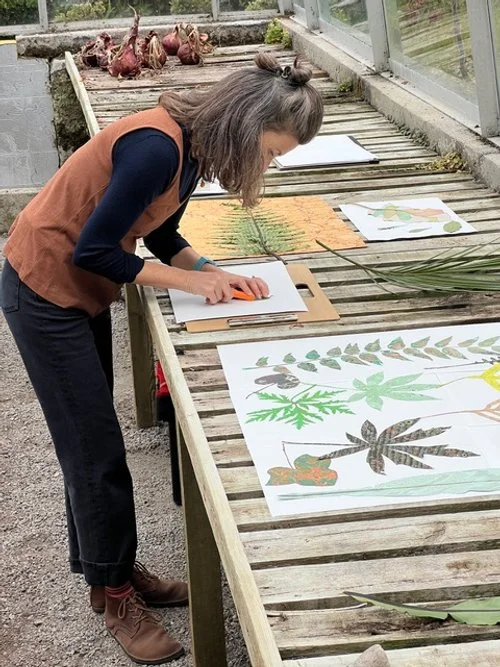“Planted on Tresco” news from our Artist’s residency with Dr Gemma Anderson-Tempini
As part of our Museum on the Move programme we’re working across the islands creating new installations and interpretation to help share each island’s unique story.
On Tresco we’re working with artist and academic Dr Gemma Anderson-Tempini to transform the island’s Garden History room into an interactive hub where visitors engage directly with Tresco's botanical, historical, and maritime past.
Gemma’s work will document some of the unique hybrid plants on Tresco – and invites visitors to explore the gardens and learn about botanical illustration, helping to create a new community art wall of plant drawings inspired by the abbey’s historic collection of plants from around the world as well as learning from the existing displays about the island’s family and maritime history.
We caught up with Gemma during her residency on Tresco in October to hear about how the work is progressing.
A Week in the Greenhouse: Botanical Metamorphosis at Tresco
Dr Gemma Anderson-Tempini
This week I've been 'planted' in the greenhouse at Tresco Abbey Gardens, transforming it into an ad-hoc studio where drawing materials nestle among palms and exotic specimens. The warm, humid air and dappled light create perfect conditions for my botanical experiments, mirroring the garden's own creative processes.
My residency focuses on Tresco's unique plant hybrids and takes inspiration from Goethe's Metamorphosis of Plants, particularly his insight that "all is leaf." For Goethe, petals, sepals, and stamens are all transformations of the same fundamental structure. A flower, he observed, is a leaf in another guise[1]. Think of it like a jazz musician improvising: they understand the underlying harmonic structure that allows infinite variations. The leaf is that underlying structure, the morphological 'grammar' from which nature composes endless plant forms.
On my last visit, I documented hybrids in flower, capturing Echium x scilloniensis, the Watsonia Tresco Hybrids, and Olearia x Scilloniensis in their full glory. This time, I'm working differently. Rather than drawing what exists, I'm exploring what could exist by creating imaginary hybrids from different leaf forms found across the garden.
At Tresco, plants from over 80 countries grow in proximity they would never naturally encounter. When an Echium from the Canary Islands meets its relative from Madeira here in the gardens, they create offspring found nowhere else on Earth.
I've been collecting leaf forms from around the garden, then systematically drawing and recombining them. I have also been developing a drawing method to share with visitors. The results are botanical experiments that have an affinity to the hybridization process that produces Tresco's actual hybrids.
The greenhouse setting feels entirely appropriate. Like the controlled environment nurturing tender plants, this makeshift studio, at this time of year, provides the right conditions for my paper experiments. Visitors occasionally peer in, curious about the drawings spreading across tables, leaf specimens pressed between pages, and invented plants emerging from careful observation.
Tresco itself is a living laboratory where human cultivation meets plant creativity. My residency extends this collaboration onto paper, using drawing as a way to think alongside the garden's ongoing evolutionary experiments. The hybrids I'm inventing may not exist in soil, but they exist in the same realm of morphological possibility that produces the garden's unique flora.
[1] It may be more accurate to say "All is apical meristem." But not quite as poetic!
Gemma’s work on Tresco is part of the development of the new Cultural Centre and Museum on St Mary’s and has been made possible by the Foyle Foundation, National Heritage Lottery Fund and Arts Council England and the new displays should be in place by Autumn 2026.
Links:
For more about Gemma’s work: www.Gemma-anderson.co.uk
